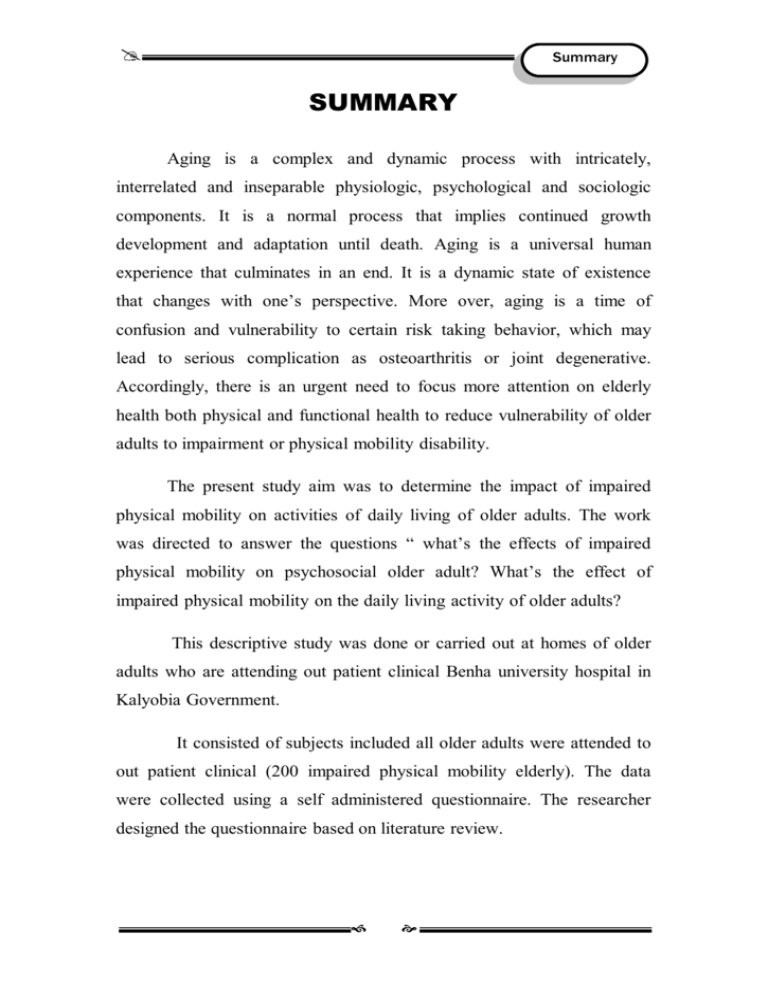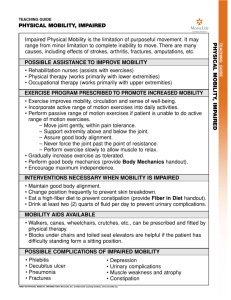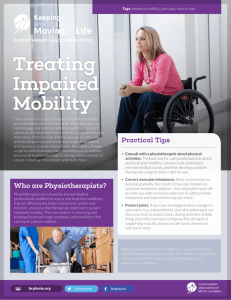SUMMARY
advertisement

Summary SUMMARY Aging is a complex and dynamic process with intricately, interrelated and inseparable physiologic, psychological and sociologic components. It is a normal process that implies continued growth development and adaptation until death. Aging is a universal human experience that culminates in an end. It is a dynamic state of existence that changes with one’s perspective. More over, aging is a time of confusion and vulnerability to certain risk taking behavior, which may lead to serious complication as osteoarthritis or joint degenerative. Accordingly, there is an urgent need to focus more attention on elderly health both physical and functional health to reduce vulnerability of older adults to impairment or physical mobility disability. The present study aim was to determine the impact of impaired physical mobility on activities of daily living of older adults. The work was directed to answer the questions “ what’s the effects of impaired physical mobility on psychosocial older adult? What’s the effect of impaired physical mobility on the daily living activity of older adults? This descriptive study was done or carried out at homes of older adults who are attending out patient clinical Benha university hospital in Kalyobia Government. It consisted of subjects included all older adults were attended to out patient clinical (200 impaired physical mobility elderly). The data were collected using a self administered questionnaire. The researcher designed the questionnaire based on literature review. 99 Summary It consisted of the following three tools socio:- demographic, characteristic, medical history, observation check list for home environment, functional assessment, activity daily living, and attitude. Likert scale adapted and modified by the researcher to assess the attitude of elders towards disease. Data were collected over three months. Throughout the period form May 2007 to December 2007. The study results revealed the following : Impaired physical mobility elderly mean age was(65.6&6.9), most females (65%) and had illiterate (31,55). Single family(36.5%) had insufficient family income(77.5%) income mean (198.588.8.0)and had non smoker (79.5% ). More than half of patients attended the rheumatology clinic, half of patient’s diagnostic osteoarthritis mean(5.3+4.7) were arthritis. Less than half of them (45.5%)had 1 year, more than half of patients attended the rheumatology clinic every six months, number of hospitalization due to rheumatic disease. Concerning history of impaired physical mobility elderly from hospital medical recorded that less than two thirds of patients (65%) their hemoglobin were normal, the majority of patients their white blood cells were high (92%), more than half of the sample their serum calcium were high (56.5%) . more than one-fourth of the sample their kidney function were high (27.5%), while less than one-fourth of patients their cretonne were high (21%), more than one-fourth of patients their liver function were high (28%), all of the sample their E.S.R were high (100%). 100 Summary Majority of the sample were high in C. reactive protein (69%), most of the sample received analgesics and narcotic (88%). And more than one tenth of patients were taken occupational and physiotherapy, more than half of the sample (53.5%) were disable. While more than one fourth of patients (29 %) positive motion, followed more than one sixth (17.5) were passive motion. More than half of patients (58%) were in pain all time, half of patients (50%) were in knee place, regular as doctor orders were(32.5%).While takes medication when feeling or experience sever pain in joint were (65%). Concerning daily living activities, unable to perform task in more than half of impaired physical mobility (61%) were home maintenance, stair climbing in more than half of cases (57.5%) on feeding in more than half of cases (56%). On the other hand, moderate help required to complete the task was observed for more than half of impaired physical mobility elderly in bowel control (54.5%) and bathing self (54%) toilet (52%).And wash (51%) while fully independent in performance task was observed for half impaired physical mobility elderly (50%) and less than half of them in telephone (48%). The highest percentage of positive attitude towards was importance of being productive at old age (90%), care toward general health most of them always (82%), more over, always prevention of taken self medication (71%), and importance of coping at old age less than three quarters (74.5%).Mean while, less than two-third of them listening to health education programs (63%). Elderly had total positive attitude (65%). 101 Summary Concerning functional capacity of the impaired physical mobility elderly, personal activity of impaired elderly in majority of cases (90%), dressing (88,5%) were moderate, while less than three quarter in hearing (71%), on the other hand, poor functional capacity was observed in less than three quarter of causes (74%). Less than three fourths of the sample (71%) of patients was the number of meals/day, 4 meals/day. Water intake, half of patients (52.5%) more than 8 glasses daily. Half of patients (50%) was sometimes practiced shoulder exercise, hip exercise, knee exercise, knee and hip exercise, more than threefourths of patients (79.0%). While more than of the sample (58.0%) hot water exercise. Concerning flexibility exercise, the majority of the sample (80.0%) was sometimes practiced by elderly patients. While more than three fourths of the sample (78.5%) walking was sometimes practiced by the patients. While climbing exercise less than two-thirds of patients (63.5 %). Concerning home environment was generally moderated in all items. On other hand, poor in ten homes especially stair and corridor, toilet poor in only fine homes. Disability scores were significantly higher among impaired physical mobility who were attitude (P<0.01). Disability scores of impaired physical mobility elderly as regard income the elderly were significantly higher among elderly income about 300 pound (P<0.01). Disability scores were significantly higher among impaired physical mobility who were aged 60 years . In conclusion, most of the studied female had disability scores of impaired physical mobility were 102 Summary significantly higher as regards age 60, income 300 pound and attitude. Disability scores were significantly higher among impaired physical mobility who were moderate environment(P<0.05). Disability scores were significantly higher between impaired physical mobility and functional capacity were (P<0.05). Based on the study findings, it is recommended that building peoples confidence and self-esteem is an important aspect of mobilization and nurses are part of amulti-disciplinary approach to the care and management of people with problems of mobility. Nurses should be aware of barriers to mobilization, in order that these can be addressed. Important to identify people who are at risk of falling and implement interventions to prevent falls. Appropriate mobility aids should be provided for each elderly with impaired physical mobility and support to people with impaired who are regaining mobility. Knee osteoarthritis sufficiently sever to consider joint replacement represents majority of all knee pain and disability suffered by older people and effected on capacity daily living activity. Health care provision in primary care needs to focus on this broader group to impact on community level of pain and disability especially on daily living activities practice and functional capacity for impaired physical mobility especially osteoarthritis. The identification of domains of physical function may be useful to health teem (physicians, physical therapists and community health nurse) in the development of interventions targeted for physical 103 Summary impairments and disabilities that contribute to deficits in performance of activities daily living. Health education programs about important range of motion practices and other exercise programme according health status, physicians order teach elderly the proper practices of exercise, healthy diet and of adequate oral hygiene should be highlighted in whole Egypt and adopting national comprehensive programme for prevention of arthritis occur especially impaired knee osteoarthritis because is essential cause for physical mobility in elderly people. Targeting intervention for physical impairments and disabilities related to function may improve the effectiveness of physical therapist, nursing care interventions to reduce the loss of independence among community – dwelling older people. Emphasize the importance of raising awareness for elderly and their care giver regarding physical mobility health and Adopt national strategies for early detection and management of impaired physical mobility causes(arthritis especially knee osteoarthritis). Assess elderly for the predisposing factors that result in their impaired physical mobility problems, and Periodic assessment and follow up of elderly to maintain health and early detect of any complications and maintain wellness of general health condition of the elderly that consequently will improve their physical condition and their ability to performing daily living activities. 104







![CHEER Seminar Promo: 2nov2015 [DOC 142.50KB]](http://s3.studylib.net/store/data/007520556_1-22ae8f83ff74a912c459b95ac2c7015c-300x300.png)